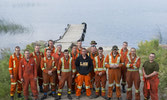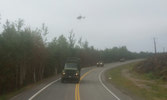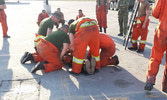Strathconas on Operation LENTUS 2015
By Cpl Curtis Rose
For the Strathcona’s, our early deployment to the wildfires happened just after a long weekend in Calgary at the Stampede Parade and Spruce Meadows. We arrived back to Garrison approximately 1800 hrs on Sunday, 5 July 2015. That day, the province of Saskatchewan had asked for military assistance in battling the wildfires, and as rumors fly, there was great speculation that we would deploy to aid 1 PPCLI in the operation.
We were assured by our OC, Maj Darryn Gray, that those scheduled to depart Alberta for summer leave would not be affected. On the following day while completing small tasks around garrison, we saw the Vanguard Company of 1 PPCLI spooling up and loading their LAV IIIs and pushing assets out the door. Upon arrival to work on Wednesday, we were notified that soldiers who were staying in the immediate area were put on an Immediate Reaction Unit, in preparation for potential deployment. We were immediately sent home to gather up any kit needed to do kit checks.
As life the Army goes, timings were pushed to Friday and we were all present at 1PPCLI to get the bus to Prince Albert, SK. On route to our destination, WO Peter Jones provided us updates on the fires as he was getting information on his Blackberry. Our biggest concern was the fear of fires conjoining to create a “monster” of a fire. Luckily enough it never happened; however there was still work that needed to be done to allow the people of La Ronge, SK and neighbouring communities to safely move back into their homes.
During our first day in Prince Albert we conducted a condensed seven hour version of what was originally supposed to be a five day firefighting course (how anyone could do five days of lectures is beyond me!). The Strathcona’s along with a mixture of other units received introductions from three civilian forestry employers, with one standing out above the rest, “Gary.”
Being from the east coast of Newfoundland, I can say in confidence that we hold a very thick and distinct accent, however, it pales in comparison to that of our instructor Gary. Gary was the truest example of a Canadian, with no lack of “Eh’s.” I wouldn’t be surprised if he mixed his cereal with maple syrup and had a pet beaver. With his slow talk and his witty “Eh’s,” it made the day pass by quickly. Immediately upon finishing our training, our kit was loaded onto a truck and we then departed Prince Albert for Camp Patricia, just south of La Ronge. We arrived at camp and right away we were put into our platoons and given our Platoon WO for the following day. All Strathconas (except Recce and HQ elements) were in both 4 and 6 platoon.
Sunday was our first day on the fire line with the Patricia’s and we were welcomed with open arms. We started on a cut line in the forest that they were working on for nearly a week. The cut line we were working on prevented the fire from jumping from the “enemy area” to the “friendly area” where the airport was. We would start around 0930 hrs after our safety brief and walk the fire line in search of hot spots. With a thick amount of clay piled up along the tree line, it was easy for more spots to flare up with dry moss underneath it all. We would walk west to the fire line and extinguish small fires and hot spots, only to come back the following day and have more in the immediate area.
While we were there, 6 Platoon spent a total of three days on that cut line. The final day at that location included an event none of us expected. We were all pulled off the line and loaded into LAVs to go search for a missing person. A soldier had gone into the woods during a break to use the washroom and suddenly gotten lost. We ceased all operations that afternoon in search of the poor guy; it turned into a massive man hunt. The LAVs were lined up along the cut line he was working on and even civilians used their helicopters in the search. The Canadian Rangers came out to make an effort to track him and the RCMP rescue dogs were a few hours out. After many extended lines and the LAV horns wailing constantly, it came over the net that he had been found.
The following day we were moved further north of camp into Sucker River. We worked on a new area of operations and consistently turned up hot spots. After a long hot day bush bashing we were given some good news, the volunteers and people who remained in the community were cooking us moose for supper. We arrived at their community center in Sucker River and they had all the moose and vegetables laid out for us on a table. One of the Elders had gathered everyone together and thanked all of us from the bottom of their hearts for being there to help save their community. It certainly was not something we were expecting, supper and all, but to know that we were there for that very reason, to save their communities, gave us all a sense of accomplishment knowing we were helping fellow Canadians.
The following couple of days we were grateful that we had heavy rain to help with the fires. We conducted patrols along the fire line and as we secured areas to the north, we rolled up fire hoses the civilian firefighters had out before securing areas further south. As we proceeded to roll up hoses, Cpl Simon Dunne, Sgt Mike Doody, and I were broken off into our own team to roll hoses. We would roll up one, and leap frog onto the next until we were done up like mules.
We secured the area surrounding Sucker River and quickly moved onto the next. We moved south east of the camp to do more hot spots, this time with more burned out areas and fallen trees. In fact, we walked nearly 15 kms and only found one hot spot near our trucks. As the wind would pick up, sections of trees would fall shortly after. While walking through the trees a sudden gust of wind blew and the next thing I knew people were screaming at me to move. Turns out, a massive tree fell two feet next to me and I nearly got hit by a widow maker. We then quickly retreated back to the trucks as we watched whole sections of trees falling at a time.
At this point, things were starting to slow down. We continued to patrol the same area until the day we headed back to Prince Albert. We spent the last day looking for receipt papers the civilian helicopters had dropped in hot areas to be picked up on their thermal imagers. Although we walked the same route the day before, the white paper was not as easy to find in a fully charred area as one might think. We found it about an hour before departing to Prince Albert and searched a few hundred meters in every direction before securing the area.
After a long week and a half, our work in the forest was complete and we were homeward bound. The sense of pride felt by all Strathconas on Operation LENTUS 2015 was immense. Although they were people we didn’t even know in places we never heard of, we were proud to help our fellow Canadians.






